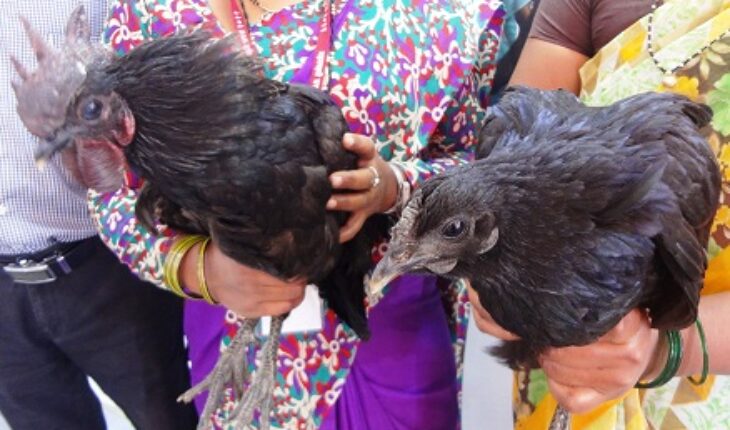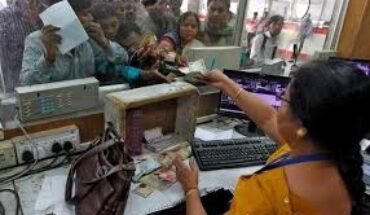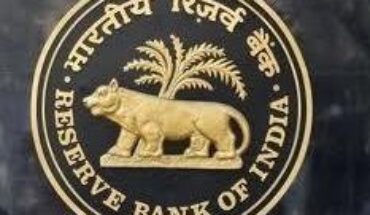From Jhabua in Madhya Pradesh to Maharashtra is a long way for a Fowl to travel, but the distance has been worth it for the breeders of this expensive breed of poultry, whose eggs sell at Rs 30 each and who makes diners pay as much as Rs 300 for a plateful ‘bite.’ This is the “Kadaknath’ black fowl whose presence is drawing interest of all visitors, especially men, at the Mahalaxmi SARAS 2019 Fair.
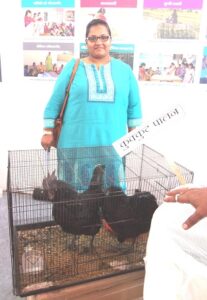 The Maharashtra Government is encouraging ‘Backyard Poultry Farming’ and the Kadaknath is among the different variety of fowl that are bred for consumption in the home kitchens and eateries of the state, said Yogesh Bhamare, manager, Maharashtra State Mission which is concentrating on various efforts to encourage the rural population in adopting various methods of alternative income.
The Maharashtra Government is encouraging ‘Backyard Poultry Farming’ and the Kadaknath is among the different variety of fowl that are bred for consumption in the home kitchens and eateries of the state, said Yogesh Bhamare, manager, Maharashtra State Mission which is concentrating on various efforts to encourage the rural population in adopting various methods of alternative income.
The ‘Backyard Farming’ programme is part of the “Yellow Revolution” (for increasing production of eggs) that has been launched by the Maharashtra Government – on the lines of the ‘White Revolution” (comprising of increasing milk production)that had been launched by Dr Verghese Kurien in Gujarat.
“People living in rural areas and not having much income can increase their earnings in many ways and backyard farming is one such scheme. Many houses in rural – and often near urban areas — have empty spaces in their backyards and so we began to promote the idea of using these spaces for setting up small-time poultry farming in which different species of fowl including the ‘Kadaknath’ could be bred for their eggs and meat,” Bhamare said.
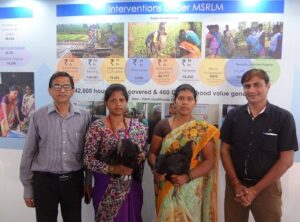 “We have 50 mother units spread over 13 districts in Maharashtra where we raise one-day-old chicks for 30 days — to reduce their mortality rate – while also enabling them to gain weight and good health. We vaccinate the poultry against the ‘Ranikhet’ disease which has receded lately. We have 15-16 types of poultry of which the best breed are: ‘Satpuda’, ‘Kaveri’ and ‘Grampriya’ that are preferred for their eggs, though of course the ‘Kadaknath’ breed stands out as the best and costliest.”
“We have 50 mother units spread over 13 districts in Maharashtra where we raise one-day-old chicks for 30 days — to reduce their mortality rate – while also enabling them to gain weight and good health. We vaccinate the poultry against the ‘Ranikhet’ disease which has receded lately. We have 15-16 types of poultry of which the best breed are: ‘Satpuda’, ‘Kaveri’ and ‘Grampriya’ that are preferred for their eggs, though of course the ‘Kadaknath’ breed stands out as the best and costliest.”
“Maharashtra is among the first states to adopt the Yellow revolution which brings in daily money for such farmers, majority of whom are housewives with plenty of time on their hands. Thus, any such breeder or self help group member – with any other type of poultry apart from these breeds can bring their eggs, even if there are barely two eggs – to us at the Maharashtra State Mission egg collection centre and get immediate payment. Every village has such a collection centre, which sends the collection to the Block Collection centre and forward on to the District level centre and so on, wherever the consumption need is greater.”
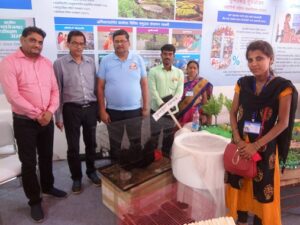 The first Phase of the ‘Yellow Revolution’ pilot project was carried out in Palghar and Dhule districts — and will soon be implemented in five other districts in the next Phase – with the eggs being supplied also to Anganwadis, Bhamare said.
The first Phase of the ‘Yellow Revolution’ pilot project was carried out in Palghar and Dhule districts — and will soon be implemented in five other districts in the next Phase – with the eggs being supplied also to Anganwadis, Bhamare said.
“Desi hens give 150-160 eggs per annum, while ‘Layer’ fowl (often called ‘English’ breed) lay 250-260 eggs in a year. Kadaknath and the other best breeds are however ‘desi’ and so we may consider using the ‘Layer’ fowl in the future for their greater egg-laying capacity.”
“We also focus in rural areas on minor agriculture schemes for those having small pieces of land which can be used for sustainable agriculture including like cereal and pulses, vegetables and so on while also increasing those rural peoples income. For successful growth of such crops, we also produce organic compost called “Jiv Amrut” that is made from cowdung and and urine mixed with jiggery and gram flour. The women from the self help groups are given training in this regard. Another organic product of ours called “Bij Amrut” is used in treatment of seed for greater germination. Also, leaves of many plants that are not eaten by grazers like cattle, goats etc are used by us to produce “Dashparni” (ten leaves extract) for use as insecticides on crops.”
“Allor Kik Khat and vermicompost (rom vermiculture), that takes 45 days to produce, is also being produced and promoted for use in rural and other areas for agriculture in 1200 villages of Maharashtra since 2014-15. We have also come out with a “Prasar Dana” meal feed (comprising maize, wheat bran and minerals ground into a mix) for feeding goats so that they give more milk,” he added.
Laxmi Nagoshe (34) of Nagoshe village in Wardha district and Dikshdanand Merade (35) of Sonala village in Wada, Palghar district are housewives who are breeding the ‘Kadaknath” and other species of fowl for supplying wherever needed for consumption.
Merade said she bred 100 such fowl and sold off 50 – for a 50% profit–in the ‘Konkan Saras’ Fair held from December 22-24 in 2018. She brought the remaining fowl for sale in the Mahalaxmi Saras 2019 Fair here in Mumbai, where they were picked up by the food stalls for producing meat dishes that are being sold for consumption at Rs 300 per plate – and for which they are witnessing a rush by such diners.
Nagoshe said that, besides Kadaknath, she also bred other poultry and goats whose milk was used by her in manufacturing ‘Goat Soap’, besides making body lotion and neem oil. “I had 50 desi hens and eight goats — when I started this business under the Government’s “Umed” scheme — in which I borrowed a loan of Rs 35,000 from the ‘Community Investment Fund” that is a village organization. I managed to breed 50 goats which I sold off and paid off the loan, while making a profit of Rs 20,500 in the bargain,” she said.


